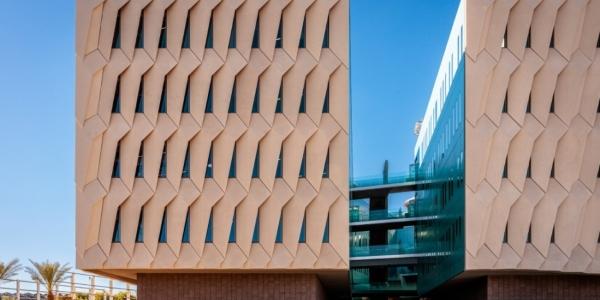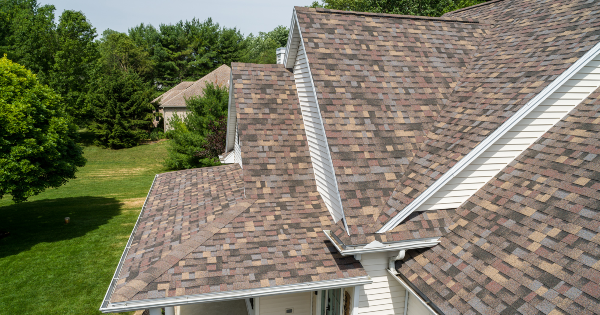New ASU Building is Above and Beyond Sustainable

By Lisa Barnard, GCP.
High-performance research facility dedicated to sustainability reaches high bar for sustainability requirements.
The Interdisciplinary Science and Technology 7 (ISTB-7) building at Arizona State University is now one of the most modern and ambitious LEED (Leadership in Energy and Environmental Design) projects on campus. The new, approximately 281,000 gross-square-foot, facility was created to foster leading-edge research centered on sustainability.
In expanding the research district at ASU’s Tempe campus, the building will give researchers a means to collaborate on pressing environmental and food challenges. In addition to offering public outreach and exhibit space, ISTB-7 will be home to the Julie Ann Wrigley Global Futures Laboratory, the Rob and Melani Walton Sustainability Solutions Service, the School of Sustainability, the Institute of Human Origins, and a five-story courtyard biome of flora and fauna.
Using a range of innovative approaches, including evapotranspiration, photovoltaics, and ASU’s own carbon-capture technology, the building is pursuing LEED Platinum status.
The challenge
Cement is carbon-intensive to produce, so reducing the amount of cement in the building’s concrete mix was an essential element in lowering the project’s embodied carbon footprint. The team set out to utilize a post-consumer byproduct to reduce the total amount of portland cement in the building structure by at least 40%. “It takes a lot of equipment and resources to produce cement,” said McCarthy Building Companies Senior Project Manager Carlos Diaz. “If you can replace a high percentage of cement with a recycled material like fly ash, you can offset a significant amount of carbon.”
In addition to the high criteria sustainability requirements, the concrete needed to be aesthetically pleasing, since it would be used in Class A architecturally exposed columns, walls, stairs, deck soffits and polished concrete floors.
The solution
Ready-mix producer Hanson Aggregates LLC, concrete contractor McCarthy Building Companies, and admixture supplier GCP worked closely together to identify the right concrete mix that could substantially reduce the amount of cement in the mix. The firms brought together significant expertise in helping customers improve building durability and reduce waste.
Lehigh Hanson and its subsidiary, Hanson Aggregates LLC, advocate for science-based research that drives innovation and sustainable building design. Named one of the top 20 green builders in the country, McCarthy Building Companies is deeply involved in the evolution of sustainable construction. And GCP develops products that make the manufacture of construction materials such as concrete more energy efficient.
Achieving the right concrete mix was no simple task. Although 40 percent cement-replacement mixes are not uncommon, they are usually used in a targeted approach, such as to control the heat of hydration. With this project, the mix would need to be applied whole scale through the entire building.
“Ready-mix concrete is sometimes viewed as a commodity, but the delivery of a product that has widescale application – especially one with architectural aspects to it – requires a significant mind shift,” said Diaz. “It takes months to determine the right mix – making sure the suppliers and chemical partners are working together to find the best admixtures and supplementary cementitious material (SCM) for the application.”
“Our principal design firm, ready-mix supplier, sustainability consultant, admixture supplier, and structural engineer worked together to identify the best mix design to meet our goals,” said McCarthy Building Companies’ Senior Project Engineer Kristine Sorensen. “There was a great deal of collaboration involved with identifying a sustainable mix design that would meet the structural integrity measures and would also look outstanding.”
“Everyone involved in the project came together to discuss different mix design scenarios and how to use locally available resources,” said Hanson Aggregates LLC. Quality Control Manager Joel Lopez Martinez. “Using high fly ash mix design for the 6,000 PSI mix is beneficial as it reduces permeability to water and produces a densified product. GCP’s admixtures played a big part in the success of this mix design, as in help with water reduction by using WRDA 64 and increasing concrete workability by using ADVA 195.”
“Many times, we have a pool of ready-mix contractors to work with and they have lots of mix designs already predetermined based on a project’s mix, strength, and flowability requirements,” said Diaz. “When you’re creating something new with high-strength requirements like this, there’s a big team effort required. Together, we gathered input from the design team and then looked at all aspects of the job to answer questions such as 'How do you control heat?’ and ‘How will the mix flow through congested rebar?”
For this mix, Hanson Aggregates, LLC, used fly ash, along WRDA 64® water reducer with ADVA® 195 superplasticizer from GCP Applied Technologies. Once they selected a mix, the team started batch trials to ensure it performed as structurally intended. Based on the success of those results, they finalized the mix and began the concrete pour.
“The ADVA® admixture gave us the opportunity to keep the water/cement ratio low while achieving high strength as well as the workability to place the concrete very easily,” said Bill Wheeler, Quality Control for Hanson Aggregates LLC. “We prefer using the ADVA® admixture because it results in fewer bubbles against the surface than midrange water reducers. This creates a smoother finish on the forms.”
Project: Interdisciplinary Science & Technology building 7 (ISTB-7)
Owner: Arizona State University
Architect/Designer: Architekton | Grimshaw
Structural Engineer: BuroHappold
Sustainability Consultant: Thornton Tomasetti
Ready-mix Producer: Hanson Aggregates LLC. (a subsidiary of Lehigh Hanson, Inc.)
Concrete Contractor: McCarthy Building Companies, Inc.
GCP Solutions: WRDA® 64 water-reducing admixture, ADVA® 195 high-range admixture
Concrete mix and specifications:
4,000 PSI for slab on grade, grade beams, caissons, caisson caps and foundation walls; 5,000 PSI for shear walls and stairs; 6,000 PSI for elevated slabs; and 8,000 PSI for columns
SCM: Class F fly ash
Aggregate: One-inch rock
Volume: 16,000 total cubic yards
Have a question? AskARoofer.
Find your local roofing contractor in the RoofersCoffeeShop® Contractor Directory.
Photo credit: ASU










Comments
Leave a Reply
Have an account? Login to leave a comment!
Sign In